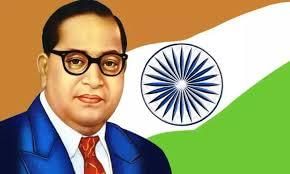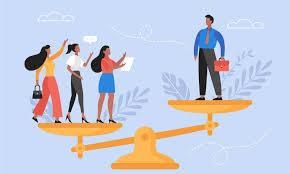Understanding Discrimination and Inequality Chapter Notes | Footprints Class 7: Book Solutions, Notes & Worksheets PDF Download
Introduction
- Dr. Bhimrao Ramji Ambedkar was a scholar, a social reformer, and a leader known for fighting against social inequality in India. He is honored as the 'Father of Indian Constitution' for his pivotal role in crafting the Indian Constitution. Dr. Ambedkar hailed from the Mahar community, who were treated as untouchables in society at that time. During his school days, he endured severe discrimination, facing exclusion from his peers and even teachers.
- Throughout his life, Dr. Ambedkar tirelessly battled untouchability and advocated for the rights of marginalized castes. He established newspapers like Mooknayak and Bahishkrit Bharat to promote the idea of social equality.

Societal Issues
- Stereotype: An oversimplified and fixed image of a group that often does not reflect reality.
How to Address: By understanding and respecting each other, avoiding generalizations. - Discrimination: Differentiating people based on factors like caste, creed, religion, or gender without considering individual merit.
How to Address: By implementing policies that uphold constitutional provisions and raising awareness.
Prejudice
Prejudice is when someone forms a biased or unfair opinion about something or someone without checking the facts. This kind of opinion isn't based on reason or real experience. Prejudice causes problems in society and holds back the progress of our country. In a diverse land like ours, it's important to know why prejudice happens.
Causes of Prejudice
- Ignorance: When people decide something before they have proof that it's true.
- Lack of sensitivity: Not being aware of others' feelings or perspectives.
- Social bias: Unfair treatment based on social differences.
- Family influence: Sometimes, even family members can create prejudice, like favoring one child over another.
- Religious and societal differences: Variations within religions or between different groups can lead to prejudice.
Effects of Prejudice
- Conflict: Prejudice causes fights between communities, which can be dangerous for peace.
- Mistrust: It increases suspicion and bitterness among people.
- Racial arrogance: Leads to division and tension among different races.
- Disunity: Creates disharmony in society and can even lead to wars.
Reducing Prejudice
- Stronger laws: Governments should make and enforce strict laws against unfair treatment.
- Education: Teaching people helps them become more open-minded and creates a better atmosphere.
- Media influence: Using media to spread positivity and encourage tolerance and harmony.
- Support for marginalized groups: Taking special steps to help those who are treated unfairly to build trust and security.
- Challenging old beliefs: Encouraging changes in attitudes by popular figures to fight prejudice.
Understanding Stereotypes and Prejudice
When people judge others unfairly based on preconceived notions, they often create stereotypes. These are simplified and fixed ideas about entire groups of people, which can be either positive or negative. Unfortunately, most stereotypes lead us to feel superior to those being stereotyped.
- Girls and Boys: Some common stereotypes include beliefs like 'Girls are not good at math or fixing things' and 'Boys do not cry'. These generalizations don't apply to all individuals and overlook the unique qualities each person possesses.
- Regional, Religious, and Economic Stereotypes: Stereotypes aren't limited to gender. They can also target specific regions, religions, races, or economic backgrounds. For instance, assumptions such as 'People with disabilities are incapable' or 'People of a certain caste are misers' can lead to hurt feelings and conflicts between different communities.
- Embracing Diversity: It's crucial to recognize that everyone and every social group has their own ways of approaching things. By understanding, respecting, and being sensitive towards each other, we can foster a more harmonious and inclusive society.
Discrimination and Inequality

- Discrimination refers to the unfair treatment of individuals or groups based on prejudice, disregarding their personal qualities or achievements. Such bias often stems from a lack of understanding and appreciation of diversity, leading to a feeling of inequality among people. When diversity is not valued, it can cause misunderstandings and become a source of discrimination.
- Inequality is the state of being unequal, arising from differences in status, access to resources, or opportunities. Social inequalities can result from a rigid caste system, while economic inequalities stem from the unequal distribution of income and wealth.
Religion and Discrimination
- Religious differences can lead to discrimination when individuals of one religion treat those of another unfairly. This can happen when people elevate their own religion and foster hatred towards others, leading to religious conflicts.
- Such differences can sometimes have serious consequences. As a secular nation, India recognizes all religions as equal under the law.
Caste System and Discrimination
- The caste system, originally designed to organize society efficiently, eventually became rigid and a source of discrimination. Over time, the system created a hierarchy of castes, with so-called higher castes considered superior and lower castes viewed as inferior.
- The upper castes often discriminated against the lower castes, especially those considered "untouchable," by denying them basic rights like accessing public wells or entering temples.
- This discrimination deprived them of opportunities for growth, respect, and dignity. After India gained independence, the Constitution abolished untouchability and aimed to ensure equal treatment for all citizens.
- Social reformers like Dayanand Saraswati, Raja Ram Mohan Roy, and Jyotiba Phule, along with writers like Munshi Premchand, worked to challenge the caste system and uplift the oppressed.
Racial Diversity and Discrimination
- An example of racial discrimination is the apartheid policy once enforced in South Africa, where non-white South Africans were treated unfairly based on their race.
- They were excluded from participating in government, restricted in their choice of residence, marriage, and education. Apartheid ended in the early 1990s, largely due to the efforts of the African National Congress and its leader, Nelson Mandela.
Gender Disparity and Discrimination
- Gender disparity can lead to inequality, as seen in the fact that women in India are often paid significantly less than men. Census data also shows that there are more men than women in the country.
- Women face discrimination in many parts of the world, with higher infant mortality rates among girls being one example. These gender-based differences highlight the issue of discrimination.
Economic Inequality and Discrimination
- Economic inequality arises from disparities in wealth and income distribution, leading to discrimination.
- In many countries, including India, poverty is so severe that people struggle to meet basic needs like food, clothing, and shelter, and often face discrimination as a result.
Striving for Equality in India
- India's struggle for independence from British rule was not only about achieving political equality between the British and Indians but also about ensuring socio-economic equality between Indians and Europeans, as well as among all Indians themselves. People from so-called lower castes, women, tribal communities, and peasants fought against the inequalities they faced in their daily lives.
- When India gained independence in 1947 and the country's leaders began drafting the Constitution, they took significant steps to eliminate all forms of inequality and discrimination. B.R. Ambedkar, who served as the chairperson of the Drafting Committee, had personally experienced social discrimination and actively fought against it. The concept of equality for all individuals is a fundamental value aimed at uniting the nation. The Constitution of India clearly asserts that everyone is equal before the law, and the Indian legal system safeguards the Fundamental Rights of every citizen. To fully realize the Right to Equality provided by the Constitution, people of all castes must overcome the existing caste system.
- The Constitution acknowledges India's rich diversity of languages, religions, and cultures. To protect this diversity and ensure equal opportunities for all citizens, the Constitution grants several Fundamental Rights:
- Right to Equality: All Indians are equal before the law, with equal rights and opportunities. They can freely choose their occupation, and no one can be denied justice or mistreated based on caste, community, gender, or religion. Untouchability is considered a crime and has been abolished by law.
- Right to Freedom: Every Indian is free to live or travel anywhere within the country and pursue any job in any part of the nation.
- Right against Exploitation: No Indian can be exploited or forced to work without pay.
- Right to Freedom of Religion: Every Indian has the right to practice the religion of their choice.
- Cultural and Educational Rights: Every community has the right to preserve and promote its own language, script, and culture.
- Right to Constitutional Remedies: This right allows citizens to seek legal recourse if their Fundamental Rights are violated.
- Even though the Constitution envisions equality for all citizens, many inequalities still persist today. It is the responsibility of informed and aware citizens to strive towards realizing the democratic values embedded in the Constitution.
Case Study Depicting Differences: Life of a Landless Farmer in Rural India
In rural India, there are farmers like Kangna who don't own land but work for others to make a living. Let's delve into Kangna's daily life to understand the challenges faced by landless farmers.
Key Points
- Kangna's Work: Kangna works on Ram Prasad's land with other villagers. She helps with tasks like preparing the land, sowing seeds, and spraying crops from 8 am to 5 pm.
- Gender Pay Gap: Kangna is paid less than men for the same work. She is only called during specific farming seasons.
- Additional Jobs: During off-seasons, Kangna weaves baskets and makes garlands to sell in the local market for extra income.
- Family Responsibilities: At home, Kangna manages household chores, while her husband Hari also works on the farm. When there's no farm work, Hari seeks employment in the city, doing labor-intensive jobs like digging or carrying materials.
- Financial Struggles: During lean periods, Hari borrows money at high interest rates, making it hard to repay. The couple considers moving to bigger cities like Delhi or Mumbai for year-round work opportunities.
Case Study: Life of an Urban Indian Woman
Meet Indra Krishnamoorthy Nooyi, an inspiring woman from Chennai, India, who became the former CEO of PepsiCo, Inc. Her journey from a small Indian town to global success is a story of determination and authenticity.
Key Points
- Starting Small: Indra hailed from a traditional family in Chennai with limited resources. Despite the odds, she pursued her dreams of higher education in the United States.
- Early Ambitions: Encouraged by her mother, Indra began dreaming big from a young age. Her mother's daily encouragement inspired her to think creatively about her future.
- Pursuit of Education: In 1978, she left India with minimal funds to study management at Yale Graduate School. To support herself, she worked odd jobs, like being a receptionist at night.
- Lesson in Authenticity: Her initial struggles with conforming to Western attire for job interviews taught her a valuable lesson. Embracing her cultural identity and wearing a sari to interviews marked a turning point in her career.
- Embracing Individuality: Indra never compromised her values or identity to fit in. She found strength in her heritage and remained true to herself, a key factor in her success.
- Global Recognition: Through hard work and authenticity, she rose to be one of the most influential women globally, recognized by Forbes for her achievements.
|
32 videos|247 docs|40 tests
|
FAQs on Understanding Discrimination and Inequality Chapter Notes - Footprints Class 7: Book Solutions, Notes & Worksheets
| 1. What is the difference between stereotypes and prejudice? |  |
| 2. How does discrimination contribute to inequality in society? |  |
| 3. How can individuals strive for equality in India? |  |
| 4. How does the life of a landless farmer in rural India depict differences in society? |  |
| 5. In what ways can understanding discrimination and inequality help create a more inclusive society? |  |
















